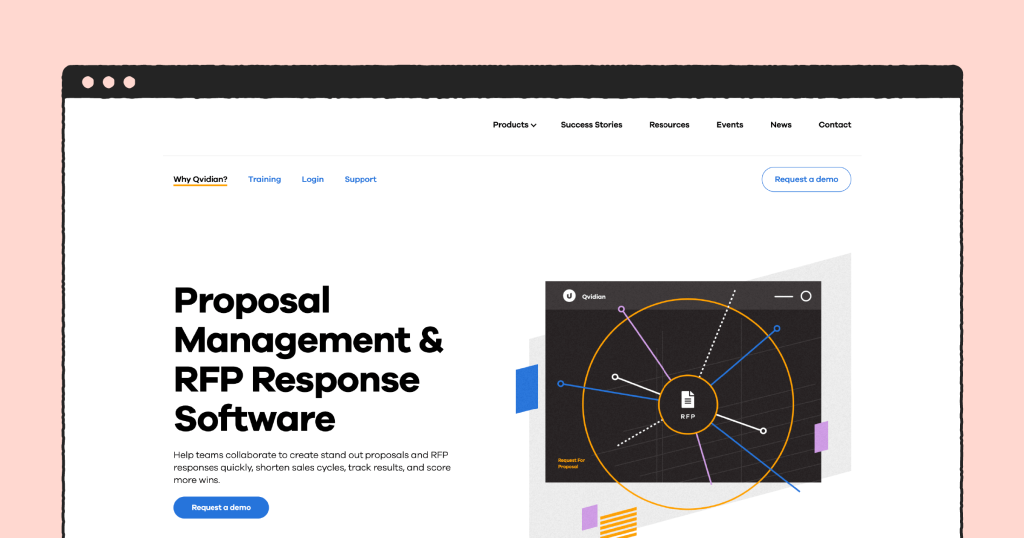When a salesperson receives a request for a proposal, it’s critical to respond quickly, yet with a quote of the highest possible quality.
The request can contain hundreds of questions, the answers to which must be highly comprehensive.
In this case, RFPIO, a major player in RFP response and proposal management software, comes to the rescue.
The software allows users to import RFPs, analyze the included requirements and questions using AI, and estimate the delivery time and chance of success.
Then, the salesperson answers the questions using the built-in corporate knowledge base and redirects to subject matter experts for those questions they’ve failed to answer without assistance.
The proposal crafting process is heavily automated, too. Having all the required information, the salesperson creates a ready-made proposal with a few clicks.
What is the RFPIO tool?
RFPIO is a proposal management software, a tool that automates and streamlines the analysis of received RFPs, answering fundamental questions directly while assigning the other ones to experts, and crafting your proposal with less effort than doing so manually.
The company expresses itself as the first-ever proposal management software actively using the power of AI.
Thanks to its AI-powered automation, as RFPIO reps claim, the tool makes it possible to craft 80% of proposals with a few clicks.
Regarding the most sophisticated 20% of proposals, RFPIO claims to shorten their preparation process by 40%.
How many customers does RFPIO have?
Currently, the company officially states the number of their customers globally has exceeded 250,000.
But is RFPIO truly unique or a best-in-class solution?
Of course, we’re biased, but it comes down to business needs and user preferences, as RFPIO clearly works well in many situations.
On one hand, this software has many helpful features, including its unique AI for importing and analyzing RFPs and searching across the database.
On the other hand, however (and based on user reviews), RFPIO has a relatively sophisticated user interface and lots of options, and these may not appeal to users interested in the shortest learning curve possible to get up and running.
Moreover, the prices start from $450 per month per user, and the software lacks both free and trial versions.
These aspects may make the software less applicable for businesses with lower revenue streams, and not offering a free trial is rather inconvenient for testing the waters.
Let’s take a look at the best RFPIO competitors through the prism of their features, applicability, and prices.
We’ve conducted a review and found 10 that are the most interesting. Some are cheaper than RFPIO; others have simpler interfaces or more efficient formatting tools.
How we sourced our data
We strive to deliver the best content quality possible, and that’s why we’re obsessed with a proper selection of data sources.
Within this article, we’ve used more than 30 sources of data, including these directories alongside many additional sources of information:
Seeking the facts, we used only trusted resources, including the official websites of the presented software systems.
Both RFPIO and each of its competitors mentioned below have high numbers of user reviews published across the above directories.
Analyzing these reviews, we’ve detected the pros and cons of the software products presented here. This has helped our subject matter experts make well-rounded conclusions.
01. PandaDoc

Price: from $0 to $49/month/user, paid annually
The best for: SMBs to enterprise-level businesses
Ease of use: 4.6/5
Functionality: 4.8/5
Free trial: yes, 14 days
We’re starting the review with our homebrew product, which definitely deserves its place here.
PandaDoc is a document workflow management software that enables you to manage proposals as well. Like RFPIO, PandaDoc has plenty of options for creating and managing your proposals, quotes, etc.
We have both a collection of customizable templates and advanced content management options, which allow users to craft compelling proposals or modify the ready-made ones in seconds.
For the Business and Enterprise pricing plans, there is also a content library option available.
This allows corporate users to create, store, update, and organize their knowledge base right within PandaDoc software.
Once you’ve created a certain content block, you can easily find and reuse it with a few clicks. With enough ready-made blocks in the library, you can easily and quickly craft quality proposals again and again.
When your proposal is ready, it’s time to send the document and track its movement within the sales funnel.
For this purpose, PandaDoc offers out-of-the-box integrations with the most popular CRM systems like Pipedrive, HubSpot, Salesforce, and Microsoft 365.
What’s more, there’s not only the possibility of managing proposals but many other business documents (contracts, quotes, invoices, etc.), whether creating them from scratch or customizing the existing templates.
Finally, PandaDoc offers a free eSignature feature for the documents created and managed in the software.
How it’s different from RFPIO
We’re not claiming PandaDoc is the clear winner when compared with RFPIO — both tools have their pros and cons, and every company has unique business needs.
The main RFPIO advantage over PandaDoc is its large array of AI-powered features. It allows users to quickly import any documents into the database and not enter them manually.
You can then use the documents or their parts in your response proposals. PandaDoc, while relying on manual input, offers similar content library features once the content is loaded.
Other pros of RFPIO include an auto-response feature, answers in bulk, AI-based recommendations and prognoses, as well as intake forms.
That said, there are many significant advantages that PandaDoc has over RFPIO.
First of all, it’s an advanced document editor that offers many more options and allows users to modify their documents and templates in very different ways — doing so is far more limited in RFPIO.
The second advantage is a built-in payment feature that allows the second party to pay right from the proposal, contract, or any other document created with the software.
One more advantage of PandaDoc is that its UI is user-friendly and intuitive. RFPIO’s UI, on the other hand, is often confusing to users, according to what can be found in reviews.
Another significant distinction of PandaDoc’s benefits is tied to pricing. It starts with the pricing itself: plans that are similar in terms of the options offered differ in prices almost tenfold.
Moreover, PandaDoc offers both a free plan with limited functionality and a free 14-day trial.
| RFPIO | PandaDoc | |
|---|---|---|
| Legally-binding eSignatures with audit trail | ✓ | Unlimited plans |
| Templates | ✓ | ✓ |
| Activities notifications | ✓ | ✓ |
| Payments collection | X | All plans |
| Automated workflows | ✓ | ✓ |
| Custom branding for documents, templates, and emails | ✓ | ✓ |
| CRM integrations | ✓ | ✓ |
| eSignature API (including Sandbox API) | ✓ | ✓ |
| Document generation and editing | ✓ | ✓ |
| Document analytics and insights | ✓ | ✓ |
| Free trial | X | ✓ |
| 24/7 customer service | ✓ | ✓ |
02. Loopio

Price: available upon request only
The best for: medium-sized to enterprise-level businesses
Ease of use: 4.8/5
Functionality: 4.3/5
Free trial: free demo upon request only
Loopio is focused on mid-size and larger businesses, offering a similar approach to RFP response management as RFPIO.
The system has advanced AI-powered automation features covering document import, “magic responses,” content library management, etc. Most of them act pretty similarly to the corresponding features of RFPIO.
Document import and analysis features show almost the same results in these two products. First of all, its AI finds and recognizes all the questions included in RFPs.
Then, a special response automation tool scans all the previous documents for the answers to the questions.
For those questions that remain unanswered, the AI seeks the best corresponding subject matter experts among the company staff who then answer these questions.
Loopio has a library of high-quality proposal templates.
They’re easily customizable, you can add sections, subsections, questions, and answers both manually and using an import option. You can modify any entry in the library and then save the changes.
The admin page is a dashboard with available preferences.
Here you can set up styles of documents in your library; assign roles and set permissions for them; add, disable, or manage users and their profiles; assign and reassign projects, and set up workgroups.
Three roles exist to work on projects, and each has a different level of permissions set: project admin, collaborator, and assignee.
The system is considered one of the most intuitive and easy-to-use in its class. Many users claimed it requires just a short initial tutorial for a successful start.
A highly responsive, friendly, and helpful support department complements this advantage.
A rare and rather valuable particularity about Loopio support is that the staff is always open to new ideas and advice on further software improvements and new features.
How it’s different from RFPIO
Despite the fact that these two software products are similar to each other — more than the others on this list — they aren’t the same, of course.
Loopio wins a competition in terms of both ease of use and support quality.
Having the highly intuitive and straightforward interface of Loopio on one side of the scale and the sometimes confusing and overloaded UI of RFPIO on the other, there is no doubt whatsoever which one is better.
Neither product comes with a free trial. Loopio, however, offers free demo access upon request, and RFPIO doesn’t have that option.
RFPIO has several significant advantages over Loopio, as well. Probably the main one is a wider feature set, including contract management, eSignature, and pipeline management features.
That said, those users focusing on proposal management may consider these features excessive.
Another field where RFPIO looks more advantageous is proposal delivery.
Users consider the Loopio features aimed at proposal delivery, tracking, and adding interactive elements as weak when compared with the corresponding features offered by RFPIO.
| RFPIO | Loopio | |
|---|---|---|
| Legally-binding eSignatures with audit trail | ✓ | ✓ |
| Templates | ✓ | Limited |
| Activities notifications | ✓ | ✓ |
| Payments collection | X | X |
| Automated workflows | ✓ | ✓ |
| Custom branding for documents, templates, and emails | ✓ | ✓ |
| CRM integrations | ✓ | Limited |
| eSignature API (including Sandbox API) | ✓ | ✓ |
| Document generation and editing | ✓ | ✓ |
| Document analytics and insights | ✓ | ✓ |
| Free trial | X | Free demo |
| 24/7 customer service | ✓ | ✓ |
03. QorusDocs

Price: available upon request only
The best for: SMB (11+ users) to enterprise-level businesses
Ease of use: 4.2/5
Functionality: 4.0/5
Free trial: free demo upon request only
QorusDocs combines RFP responding and proposal generation features. There are many helpful features inside, and some of them are powered by its original AI.
The platform supports an automatic analysis and answering engine: the system scans incoming documents and finds questions that must be answered.
Then, AI analyzes the database and finds answers where it is possible. Finally, the tool helps automate answers by offering their drafts within what’s found in the database.
QorusDocs has comprehensive integration with the Microsoft Office suite for more convenient editing. There is also a feature for simultaneous editing by several users, as well.
A proposal template hub is a set of differently-designed templates of documents that can be modified in the way you need them.
Some other features include document tracking once docs are sent, as well as native integration with several popular CRMs and API support for that third-party software that hasn’t been supported out of the box.
How it’s different from RFPIO
This system has much more similarities with RFPIO than differences. Both systems have their AIs for process automation. Both offer RFP automated analysis, auto-response features, as well as template collection.
Again, both software tools have no trial or free versions. In both cases, however, you can ask their staff for free demo access.
Both systems offer similar quality of online and phone support, live chat 24/7, as well as knowledge bases, FAQs, corporate pieces of training, and blogs.
Based on users’ reviews, we found some significant differences between the two software systems. RFPIO has a more user-friendly and straightforward user interface than QorusDocs.
Taking that into account, and according to multiple user reviews, RFPIO overall does not have the best UX, and this is one reason to think twice before buying QorusDocs or RFPIO for your business.
One more difference is in the lists of natively supported platforms: RFPIO has mobile apps for iOS and Android; QorusDocs, however, has no mobile apps but is equipped with desktop versions for both Windows and Mac.
| RFPIO | QorusDocs | |
|---|---|---|
| Legally-binding eSignatures with audit trail | ✓ | ✓ |
| Templates | ✓ | ✓ |
| Activities notifications | ✓ | ✓ |
| Payments collection | X | X |
| Automated workflows | ✓ | ✓ |
| Custom branding for documents, templates, and emails | ✓ | ✓ |
| CRM integrations | ✓ | ✓ |
| eSignature API (including Sandbox API) | ✓ | X |
| Document generation and editing | ✓ | ✓ |
| Document analytics and insights | ✓ | ✓ |
| Free trial | X | Free demo |
| 24/7 customer service | ✓ | ✓ |
04. Proposify

Price: from $49/month/user
The best for SMBs (up to 500 users)
Ease of use: 4.2/5
Functionality: 4.3/5
Free trial: yes, 14 days
Proposify is a proposal management software that offers helpful features for sales representatives and their managers.
The system is aimed mostly at proposal management and offers some interesting features here but lacks the RFP response management abilities of others on this list.
For example, there are no RFP analysis tools that help answer the questions included in requests.
At the time, you can easily modify any existing proposal from those previously prepared, or make any changes in templates offered, using a simple drag-and-drop interface.
These nuances shape the purpose of Proposify: rather than working with complex RFPs containing dozens of difficult questions, it is aimed at simpler and less detailed offers, which could be crafted here quite efficiently.
First of all, you can change the look and feel of the proposal: colors, block types, sizes, fonts, headings, illustrations, tables, etc.
Then, the system allows users to add some sales-oriented features like interactive quotes where their clients can choose the most appropriate option from several ones right inside the document.
Finally, once the proposal is sent, Proposify offers some features for further tracking. The range of tools here is impressive — the system acts as a special CRM.
One more feature that must be mentioned is the possibility of sharing the document among all the parties involved.
How it’s different from RFPIO
As we said before, Proposify itself is aimed more at the management of proposals rather than requests. That’s why the tool offers a similar knowledge library and tools for its management.
The questionnaire-related features, however, are quite limited here. While RFPIO offers auto-responses, bulk answers, and a bunch of AI-powered automation tools, Proposify doesn’t do the same or even come close with respect to functionality.
Both platforms have document management features, but Proposify looks more comprehensive and advanced.
In addition, the system is considered more user-friendly and has a more straightforward user interface than RFPIO.
Some other advantages of Proposify are undoubtedly its payment and electronic signature options.
These features are quite similar to those of PandaDoc, but PandaDoc’s payment ability includes not only Stripe among the offered options but also PayPal, Square, banking cards, merchant accounts, etc.
It can be said that Proposify handles proposal generation much better than RFPIO.
But in the field of RFP response features, it more likely serves up a compromised solution. It is also aimed at smaller businesses compared with the stated focus of RFPIO.
| RFPIO | Proposify | |
|---|---|---|
| Legally-binding eSignatures with audit trail | ✓ | 100 |
| Templates | ✓ | ✓ |
| Activities notifications | ✓ | ✓ |
| Payments collection | X | Stripe |
| Automated workflows | ✓ | X |
| Custom branding for documents, templates, and emails | ✓ | ✓ |
| CRM integrations | ✓ | ✓ |
| eSignature API (including Sandbox API) | ✓ | X |
| Document generation and editing | ✓ | ✓ |
| Document analytics and insights | ✓ | ✓ |
| Free trial | X | ✓ |
| 24/7 customer service | ✓ | Limited |
05. Qwilr

Price: from $35/user/month
The best for: SMB to enterprise-level businesses
Ease of use: 4.3/5
Functionality: 4.4/5
Free trial: yes, 14 days
The Qwilr proposal management software is aimed at a wide range of businesses from micro to enterprises.
The system is focused on proposal generation features but doesn’t have enough leverage when it comes to RFP response management.
Yes, you can find a content library that helps answer questions faster and more accurately, but almost nothing extra for this scope of tasks.
The main toolset covers different, useful features for the design and layout of your proposals and other supported types of documents.
The unique feature of Qwilr is named Qwilr Pages — the proposals you’re creating are hosted online and can be accessed for reading and editing via the web at any moment.
Despite this fact, Qwilr has a less robust and flexible document editor tool than, for example, PandaDoc.
As a result, the documents created in Qwilr look more like glossy web pages and don’t exactly fit when you need something simple like a contract or business letter free of these visual jewels.
The sharing feature is fully secure, all the documents are accessible only to those with whom they were shared. By the way, you can also export any of your documents in PDF format.
The system also offers integrations with some third-party software like HubSpot, Salesforce (for the enterprise pricing plan only), Zapier, and some others, as well as API for those which haven’t been covered automatically.
How it’s different from RFPIO:
When compared with RFPIO, Qwilr offers significantly fewer features than our last competitor.
Here you won’t find contract management, CRM features like pipeline management or version control for the documents from your content library. There is also much less leverage when compared to RFP automation.
At the same time, users mentioned that, on average, the documents made using Qwilr look more glossy and polished than the ones created in RFPIO.
What is also important, Qwilr offers an add payments feature right into the documents and makes it possible to sign them electronically.
As a result, you can see that Qwilr is aimed more at crafting compelling documents rather than answering automation — which is more in line with the RFPIO offering.
These two software products, by the way, have a lot of intersecting features.
There is also the possibility of trying out Qwilr by using their 14-day free trial, something that RFPIO lacks.
| RFPIO | Qwilr | |
|---|---|---|
| Legally-binding eSignatures with audit trail | ✓ | ✓ |
| Templates | ✓ | ✓ |
| Activities notifications | ✓ | X |
| Payments collection | X | ✓ |
| Automated workflows | ✓ | X |
| Custom branding for documents, templates, and emails | ✓ | ✓ |
| CRM integrations | ✓ | ✓ |
| eSignature API (including Sandbox API) | ✓ | X |
| Document generation and editing | ✓ | ✓ |
| Document analytics and insights | ✓ | ✓ |
| Free trial | X | ✓ |
| 24/7 customer service | ✓ | Limited |
06. Better Proposals

Price: from $19/user/month
The best for: freelancers and SMBs (up to 1,000 users)
Ease of use: 4.7/5
Functionality: 4.6/5
Free trial: yes, 14 days
Better Proposals is a cloud-based proposal management software with functionality close to the just-reviewed Qwilr.
The system makes it possible to build compelling proposals and many other types of sales-related documents, and at a level of cost-efficiency among the highest within our list.
Taking also into account a free 14-day trial, Better Proposals is one of the best options to take for a spin.
This highly attractive price, however, has its reverse side: the number of available proposals for the $19 starting plan is only 5 per month!
The second tier costs $29, and the limit here is 50, which isn’t enough for the most active businesses, either.
The way to eliminate these roadblocks is to switch to their Enterprise plan, which costs $49/user/month. To be honest, after such a switch, the advantage of Better Proposals isn’t quite so evident.
The document creation process, as in most of our competitors, is based on a library of ready-made templates.
There are not only proposals but also many other document types, including RFP requests, contracts, statements of work, quotes, marketing collateral, etc. Based on official info, there are more than 200 templates available, as well as the custom template builder feature.
The document-building tool is block-oriented. You can decide whether to start with a blank document or select one of the templates offered.
Next, it is easy to add, remove, or modify blocks in various ways. These could be headings, text paragraphs, pricing tables, images, etc.
Real-time collaboration features you can use in Better Proposals include live chat and messaging. You can also equip your documents with payment or eSignature options.
Finally, once the document is sent, Better Proposals makes it possible to become aware of each opening, signing, or sending along the document journey.
How it’s different from RFPIO
RFPIO surely looks more comprehensive in terms of supported features when compared to Better Proposals.
This means that RFPIO, among others, offers many valuable automation tools, which assist in sorting incoming documents, analyzing them, and finding answers to the questions where it is possible.
Better Proposals has no auto recognition tools and no automated answers feature. Instead, users can rely on a convenient visual editor with an acceptable UI and some smart options.
The one that is surely worth a mention is Proposal AI — automated suggestions on how to improve your document.
By the way, both systems have their content libraries, making it possible to use already prepared content pieces more than once.
In addition, Better Proposals offers a bulk style change for multiple documents simultaneously.
The next big difference is a lack of version control and workflow management features in Better Proposals, things which RFPIO has.
This is the evidence that RFPIO is more focused on process efficiency, whereas Better Proposals is aimed more at a creative feature set.
There are also significant differences in the support options offered by these two products.
While RFPIO has an entire range of available support options, Better Proposals has no FAQ or forum on their website, and the support’s working hours aren’t 24/7.
| RFPIO | Better Proposals | |
|---|---|---|
| Legally-binding eSignatures with audit trail | ✓ | ✓ |
| Templates | ✓ | ✓ |
| Activities notifications | ✓ | ✓ |
| Payments collection | X | No data available |
| Automated workflows | ✓ | ✓ |
| Custom branding for documents, templates, and emails | ✓ | ✓ |
| CRM integrations | ✓ | 11 |
| eSignature API (including Sandbox API) | ✓ | ✓ |
| Document generation and editing | ✓ | X |
| Document analytics and insights | ✓ | ✓ |
| Free trial | X | ✓ |
| 24/7 customer service | ✓ | Limited |
07. Ignition (former Practice Ignition)

Price: from $75/month (unlimited number of users, a limited number of clients)
The best for: small businesses (up to 50 users) offering any professional services
Ease of use: 4.6/5
Functionality: 4.5/5
Free trial: yes, 14 days
Ignition, one of the most expensive tools in our comparison today (except RFPIO itself, with its extremely high price), is a solution focused on small businesses providing different professional services.
The system is positioned as a client engagement and eCommerce platform for professional services businesses.
That’s why the scope of features presented here is much wider than that of the typical RFP or proposal management software.
As a result, Ignition combines the features of accounting practice management, contract management, customer experience, digital signature, proposal management, quoting, and tax practice management software.
Ignition offers coverage for the main sales activities from crafting proposals to automating the established relationships with existing clients.
Here you can craft your proposal or quote from scratch or by using one of the templates, save the result into a database, send the document to the client, track the corresponding activities, make the other party sign it electronically and pay for the services, as well as set up any recurring actions.
But in the field of proposal management, the system offers less than its average competitors.
For example, it lacks such important features as knowledge base management, pipeline management, as well as RFP response management features we’ve already become accustomed to seeing in the products presented here.
The price of Ignition may look unsettling at first, compared, for example, to PandaDoc.
PandaDoc has several free features, as well as much cheaper tiered pricing, while Ignition has a less convenient document editor, fewer templates in the collection, and a rather limited number of supported integration.
But let’s take into account what you’re paying for. First, all the plans offer an unlimited number of users; it just limits the number of clients.
For the small businesses offering B2B services, the number of clients on average is usually made up of a few companies, so this limit isn’t a bottleneck in most cases.
Second, the software offers many additional tools making it possible to omit some third-party ones and substitute them with Ignition. So, this price might be even lower in some contexts.
How it’s different from RFPIO
There is no point in comparing all the features of these two solutions; let’s focus on those tied to proposals.
Both RFPIO and Ignition have the tools for creating proposals from scratch or modifying one of the existing templates from the built-in library.
Proposals in both cases can contain interactive elements, but only Ignition supports adding videos here.
The main difference here is in the process employed: Ignition offers a manual approach, whereas RFPIO has its powerful AI-based automation feature set described above.
As a result, the process of answering the questionnaires using RFPIO is usually far faster.
The advanced payment options Ignition offers are one of the main advantages of Ignition over RFPIO.
The system allows you to add payment possibilities right into the document, receive the payment details right while the second party is reviewing the document, or even set recurring payments.
The next difference is that RFPIO has iOS and Android mobile apps along with its web-based version. Ignition, in turn, is accessible only by the web and has no platform-specific applications.
The quality of both UI and support is rather close for these two products. The only difference is that Ignition has no around-the-clock support.
| RFPIO | Ignition | |
|---|---|---|
| Legally-binding eSignatures with audit trail | ✓ | ✓ |
| Templates | ✓ | ✓ |
| Activities notifications | ✓ | ✓ |
| Payments collection | X | ✓ |
| Automated workflows | ✓ | ✓ |
| Custom branding for documents, templates, and emails | ✓ | ✓ |
| CRM integrations | ✓ | ✓ |
| eSignature API (including Sandbox API) | ✓ | X |
| Document generation and editing | ✓ | ✓ |
| Document analytics and insights | ✓ | ✓ |
| Free trial | X | ✓ |
| 24/7 customer service | ✓ | X |
08. Qvidian

Price: available upon request only
The best for: from SMB (11+ users) to enterprise businesses, especially in regulated industries
Ease of use: 4.0/5
Functionality: 4.1/5
Free trial: free demo upon request only
Qvidian is one of the oldest presented in this list of RFP response and proposal management software systems. But it doesn’t necessarily mean that this is best-in-class software, of course. Let’s take a closer look.
During its long history, the software has implemented all the basic features for efficient RFP responses and crafting compelling proposals.
This set of features is pretty similar to the one RFPIO offers. Once you’ve received your RFP, AI analyzes its text to find the questions.
Then, it scans the built-in knowledge base, finding answers for those questions where it is possible, and matching experts for the others.
When all the answers are ready, the system offers to create a proposal using a ready-made template from the library.
During its long operational history, Qvidian gathered the biggest template collection among its competitors.
These templates can be changed in any way you like and then saved into the database for further usage. The version control feature allows users to return to any previous version of the modified template.
The system also allows you to track the documents that were already sent. You can use different analytical presets, or even build your custom dashboard.
How it’s different from RFPIO
First of all, RFPIO is more universal in terms of targeted audience, and Qvidian is much more specific, focusing mostly on medium-sized businesses in regulated fields.
Next, Qvidian is better suited for medium-sized companies and enterprises.
Another significant difference is that Qvidian is a product of Upland Software, a company that has dozens of other business-focused software products.
All these products can be integrated with ease, expanding the functionality of Qvidian seamlessly.
If we speak about the Qvidian functionality alone, it compares with the RFPIO functionality kind of poorly, especially with respect to pipeline management features.
Both systems have virtually the same auto-responding features but there is some evidence from users that Qvidian’s auto-search tool works strangely at times, often requiring several attempts for getting the right answers.
Finally, both of the products have questionable UIs but the Qvidian interface is definitely less friendly due to being slightly outdated.
| RFPIO | Qvidian | |
|---|---|---|
| Legally-binding eSignatures with audit trail | ✓ | X |
| Templates | ✓ | ✓ |
| Activities notifications | ✓ | ✓ |
| Payments collection | X | X |
| Automated workflows | ✓ | ✓ |
| Custom branding for documents, templates, and emails | ✓ | ✓ |
| CRM integrations | ✓ | X |
| eSignature API (including Sandbox API) | ✓ | X |
| Document generation and editing | ✓ | ✓ |
| Document analytics and insights | ✓ | ✓ |
| Free trial | X | ✓ |
| 24/7 customer service | ✓ | Limited |
09. DocSend

Price: $45/user/month for Standard, paid annually
The best for: from SMB to enterprise-level businesses
Ease of use: 4.5/5
Functionality: 4.3/5
Free trial: yes, 14 days
Actually, DocSend by Dropbox isn’t an RFP response or proposal management software. First and foremost, it is a suite for common document management.
This is the reason why DocSend doesn’t have any dedicated proposal creation features.
For document creation purposes, you must use something different.
There are tons of different third-party tools ranging from simple text editors to powerful all-in-one solutions like Adobe InDesign. The result should be a document in any of the formats supported by DocSend.
Once the content is ready, it’s time to try out those features that reserved DocSend a place on our list.
Right after the document is uploaded, DocSend allows you to share the document safely and then control it conveniently and easily.
With the Virtual Data Room feature, you can create separate spaces, each with its own subdomain, for sharing multiple documents using a single link. Each space can be protected with a password.
There are some other interesting features on offer as well, like adding watermarks in one click, or the NDA application, which is available only within the two most expensive pricing plans.
The system also allows its users to modify the already shared content at any time they want.
Document tracking features include notifications after each interaction with the tracked document, gathering valuable analytical data, as well as identification of users to whom the document was forwarded for finding new stakeholders.
How it’s different from RFPIO
As we said before, these two systems are more different than similar. The main difference is that DocSend lacks an editor, so making the comparison of related features isn’t an option.
Some features are common between these two products. Among them, for example, are an electronic signature possibility, and some out-of-the-box integrations with third-party software.
When it comes to file sharing, tracking, and analytical features, DocSend has more advanced tools than RFPIO in almost every single category.
One of the brilliant advantages of DocSend is that all the files you’re sharing will remain fully under your control, and you can revoke access at any moment without even notifying the second party.
There are, however, some rather helpful features that RFPIO offers but DocSend doesn’t have at all. These features are mostly tied to AI, like risk prediction and 4th party assessment options.
As far as the pricing comparison, it’s challenging for such different products. While the RFPIO price looks extremely heavy, it is worth considering the combination of DocSend plus any convenient editor.
The resulting price of the two products will probably be lower than the price of RFPIO itself.
| RFPIO | DocSend | |
|---|---|---|
| Legally-binding eSignatures with audit trail | ✓ | Unlimited |
| Templates | ✓ | ✓ |
| Activities notifications | ✓ | ✓ |
| Payments collection | X | X |
| Automated workflows | ✓ | ✓ |
| Custom branding for documents, templates, and emails | ✓ | ✓ |
| CRM integrations | ✓ | 2 |
| eSignature API (including Sandbox API) | ✓ | $ |
| Document generation and editing | ✓ | Limited |
| Document analytics and insights | ✓ | Limited |
| Free trial | X | ✓ |
| 24/7 customer service | ✓ | X |
10. DealHub.io

Price: available upon request only
The best for: from medium-sized to enterprise-level businesses (50+ users)
Ease of use: 4.5/5
Functionality: 4.7/5
Free trial: no
DealHub.io (former Valooto) is a combination of two products under one roof: DealRoom for proposal management and DealHub CPQ for complex pricing quotes.
There is no need to consider them separately.
The document creation features of DealHub.io are aimed at crafting proposals and quotes of the highest possible quality, and with the least amount of effort.
Saving time is organized via the package of ready-made document templates, as well as the new template creation option.
The software makes it possible to use your CRM as a source of data.
Among the integrated CRM software options are Salesforce, HubSpot, Microsoft Dynamics, Freshworks, and SugarCRM. The connection process is quite simple and requires just a few clicks.
The CPQ scope of features is worth special mention.
One of them is guided selling, allowing you to create workflows based on questions that will help your salespersons configure, price, and quote your complex products and services much easier and accurately.
One more group of features covers subscription management, available with the highest pricing plans. These features help businesses in every aspect of managing their subscriptions.
The software automates all subscription-related processes, including the subscriptions themselves, renewals, cross-selling and upselling, etc.
How it’s different from RFPIO
The difference between RFPIO and DealHub.io is tied to their different purposes.
RFPIO’s main goals are to help users complete the absolute majority of proposals in seconds, respond faster, and increase the success rate.
For DealHub.io, the main goal is to guide salespersons, automate their effort in terms of subscription management, and improve the accuracy of quotes.
As a result, the difference between these two products becomes fairly visible. First of all, the content pieces prepared using RFPIO usually look much more glossy.
At the same time, the conversion rates of the content created in DealHub.io can be even higher sometimes, thanks to their high data accuracy.
The purpose behind choosing DealHub.io can be tied to a complicated product or service you’re selling, one that is hard to be priced properly.
Or if your business is subscription-based, which makes corresponding features very much in high demand.
Either way, you must choose your new proposal management or RFP responding tool thoroughly, especially when it comes to such bespoke software.
| RFPIO | DealHub.io | |
|---|---|---|
| Legally-binding eSignatures with audit trail | ✓ | ✓ |
| Templates | ✓ | ✓ |
| Activities notifications | ✓ | ✓ |
| Payments collection | X | X |
| Automated workflows | ✓ | ✓ |
| Custom branding for documents, templates, and emails | ✓ | ✓ |
| CRM integrations | ✓ | Limited |
| eSignature API (including Sandbox API) | ✓ | X |
| Document generation and editing | ✓ | X |
| Document analytics and insights | ✓ | ✓ |
| Free trial | X | X |
| 24/7 customer service | ✓ | Limited |
Conclusion
Every business is somehow different from its competitors. Some of the differences are so minuscule it’s hard to tell one from the other.
These factors can make choosing between RFPIO or selecting one of the substitutes from the options offered here a challenging process — after all, the results are extremely important to your business.
There are, however, many other factors you must take into account.
For example, most of the software tools described above are aimed at a certain size of clients’ businesses or their specific domains. And they work poorly with other sizes or types of companies.
The price factor is just as important. Many RFP responding and proposal management software options lack free trials or free versions, and some of them require yearly payments right at the start.
But relying on something you’ve never taken for a test drive before is almost certainly a bad idea.
Start with something that looks the most appropriate for your business and offers no charge to take it for a spin.
For example, PandaDoc has a 14-day free trial, where you can use all the features for free, the same as in the paid access tier.
Use this opportunity for understanding whether PandaDoc is the best fit for you and all the different aspects that make your company unique!
Disclaimer
PandDoc is not a law firm, or a substitute for an attorney or law firm. This page is not intended to and does not provide legal advice. Should you have legal questions on the validity of e-signatures or digital signatures and the enforceability thereof, please consult with an attorney or law firm. Use of PandaDocs services are governed by our Terms of Use and Privacy Policy.
Looking For Document Management System?
Call Pursho @ 0731-6725516
Check PURSHO WRYTES Automatic Content Generator
https://wrytes.purshology.com/home
Telegram Group One Must Follow :
For Startups: https://t.me/daily_business_reads




